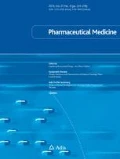Abstract
Drug and biological inventions have shorter periods of exploitation than typical commercial products because their long development cycles subtract from the uniform 20 years-from-filing patent longevity. However, in the US, market exclusivity for new drugs and biologicals need not derive solely from such patents. Understanding how additional exclusivity may be obtained, due to statutory provisions for new products, patent-term restoration for US Food and Drug Administration (FDA) review times, orphan drug designation, paediatric research, and being a first-to-market bioequivalent, is essential to maximize innovator revenues during the lifespan of a given product. Non-patent types of market exclusivity also often have a complex relationship with the part of the statute that theFDArelies upon in order to grant original or supplemental marketing approval.

Similar content being viewed by others
Notes
The author has no direct knowledge of the strategic development path for Brevibloc®. The example described represents a theoretical plan that has been created based upon publicly available information.
References
Best Practice, LLC. Effectiveness of pharmaceutical lifecycle management tactics [online]. Available from URL: http://www3.best-in-class.com/bestp/domrep.nsf/Content/87B1FEF42F766EFE85256F6C0066690F!OpenDocument [Accessed 2009 Jun 2]
Glover GJ. The influence of market exclusivity on drug availability and medical innovations. AAPS J 2007; 9 (3): E312–6
French H. Maximizing exclusivity for drug products. Nature Rev Drug Discovery 2005 Sep; 4: 709
Methods of maximizing exclusivity for pharmaceutical products. Goliath Business News 2003 Oct 22 [online]. Available from URL: http://goliath.ecnext.com/coms2/gi0199-33827777/Methods-of-Maximizing-Exclusivity [Accessed 2009 Mar 20]]
Fernandez DS, Huie JT. Strategic balancing of patent and FDA approval processes to maximize market exclusivity [online]. Available from URL: http://www.iploft.com/PTO-FDA.pdf [Accessed 2009 Mar 20]
Federal Food, Drug, and Cosmetic Act, Pub. L. No. 75-717, 1938 Jun 25. Chapter V — drugs and devices
Drug Price Competition and Patent Term Restoration Act of 1984 (Hatch-Waxman Amendments), Pub. L. No. 98-417, 1984 Sep 24
21 CFR Part 60 — patent term restoration
21 CFR Part 312 — investigational new drug application
21 CFR Part 314 — applications for FDA approval to market a new drug
21 CFR Part 601 — Licensing, y601.2 — applications for biologics licenses; procedures for filing
21 CFR Part 314 — applications for FDA approval to market a new drug, §314.108 — new drug product exclusivity; (a) definitions
US Food and Drug Administration, Center for Drug Evaluation and Research. Frequently asked questions on the Patent Term Restoration Program, 2008 May 12, update
Orphan Drug Act, Pub. L. No. 97-414, 1983 Jan 4
Health Promotion and Disease Prevention Amendments, Pub. L. No. 98-551, 1984 Oct 30
Orphan Drug Amendments of 1985, Pub. L. No. 99-91, 1985 Aug 15
Public Law No. 100-290, 1988 Apr
Federal Food, Drug, and Cosmetic Act, Sec. 526. Designation of drugs for rare diseases or conditions
21 CFR Part 316 — orphan drugs
Federal Food, Drug, and Cosmetic Act, Sec. 505. New drugs
21 CFR Part 320 — bioavailability and bioequivalence requirements
21 CFR Part 314 — applications for FDA approval to market a new drug, §314.3(b) Definitions
US Food and Drug Administration, Center for Drug Evaluation and Research. Small business assistance, 180-day generic drug exclusivity, 2001 Sep 13
21 CFR Part 314 — applications for FDA approval to market a new drug, §314.108. New drug product exclusivity
US Food and Drug Administration, Center for Drug Evaluation and Research. Guidance for industry, applications covered by Section 505(b)(2), 1999 Oct [draft]
US Food and Drug Administration, Center for Drug Evaluation and Research. Frequently asked questions for new drug product exclusivity, 2006May 3, update
Best Pharmaceuticals for Children Act, Pub. L. No. 107-109, 2002 Jan 4
Food and Drug Administration Modernization Act, Pub. L. No. 105-115, 1997 Nov 21
US Food and Drug Administration, Center for Drug Evaluation and Research. Guidance for industry, qualifying for pediatric exclusivity under Section 505A of the Federal Food, Drug, and Cosmetic Act, 1999 Sep 1999
US Food and Drug Administration, Center for Drug Evaluation and Research, Drugs@FDA, FDA Approved Drug Products [online]. Available from URL: http://www.accessdata.fda.gov/scripts/cder/drugsatfda/index.cfm [Accessed 2009 Mar 20]
Acknowledgements
The author has no conflicts of interest that are directly relevant to the content of this review. No sources of funding were used to assist in the preparation of this review.
Author information
Authors and Affiliations
Corresponding author
Rights and permissions
About this article
Cite this article
Luchetti, C. Market Exclusivity Strategies for Pharmaceuticals. Pharm Med 23, 77–84 (2009). https://doi.org/10.1007/BF03256753
Published:
Issue Date:
DOI: https://doi.org/10.1007/BF03256753




